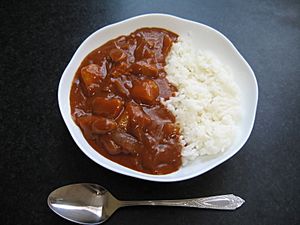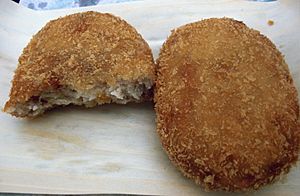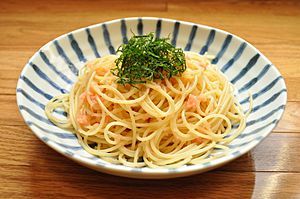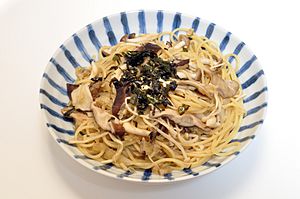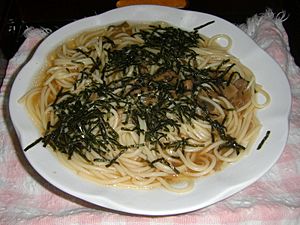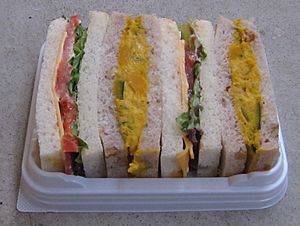Yōshoku facts for kids
In Japanese cuisine, yōshoku (洋食, meaning "western food") is a special style of cooking. It mixes Western and Japanese ideas. This type of food started in Japan during the Meiji Restoration (a time when Japan changed a lot).
Yōshoku dishes are usually Japanese versions of European meals. They often have Western names, which are written using katakana (a Japanese writing system for foreign words). It's a great example of fusion cuisine, where different food traditions come together.
How Yōshoku Began
When the Meiji Restoration started in 1868, Japan opened its doors to the world after a long time of being closed off. The Emperor Meiji believed that Western ideas would help Japan grow. As part of these changes, the Emperor allowed people to eat red meat again. He also encouraged Western cooking. People thought eating Western food would make Japanese people bigger and stronger, like Westerners.
So, yōshoku dishes often use meat, which was different from most Japanese food at that time. Also, many Westerners who moved to Japan didn't like traditional Japanese food. Their Japanese chefs learned to cook Western-style meals, often adding a Japanese twist.
The word "yōshoku" first appeared in print in 1872. Back then, it meant any Western food, no matter where it came from. But by the 1980s, people started to see the difference between true European food and yōshoku. This was because many European restaurants opened, serving more authentic dishes.
In 1872, a Japanese writer named Kanagaki Robun wrote a popular book called Seiyō Ryōritsū (meaning "Western Food Handbook"). He used the term seiyō ryōri. This term usually refers to French and Italian cooking. Yōshoku, on the other hand, is a general name for Japanese dishes inspired by Western food. These dishes are different from traditional Japanese food, called washoku.
Another key difference is how you eat them. You usually eat seiyō ryōri with a knife and fork. But you eat yōshoku with chopsticks and a spoon.
Some Japanese foods, like tempura, came from Portugal in the 1500s. Even though they have European roots, they are not strictly yōshoku. Yōshoku only refers to foods that started during the Meiji era. However, some yōshoku restaurants might still serve tempura.
Yōshoku Today
Yōshoku dishes can be very similar to Western food or very Japanese. For example, some yōshoku dishes are eaten with a spoon, like karē (curry). They might be served with bread or a plate of rice (called raisu). Their names are often written in katakana because they come from foreign words.
But some yōshoku dishes have become so Japanese that people often think of them as regular Japanese food (washoku). An example is katsu (a fried cutlet). You eat katsu with chopsticks and a bowl of rice (gohan). It can even be served with traditional Japanese sauces like ponzu. Because it's so common, katsu is often written in hiragana (another Japanese writing system) as かつ, like a native Japanese word.
A yōshokuya (洋食屋) is a restaurant that serves yōshoku dishes. In the past, people often ate yōshoku in department store restaurants. Today, family restaurants like Denny's and Saizeriya are popular places for yōshoku. There are also fancy yōshoku restaurants in Japan, like Shiseido Parlor in Ginza.
Popular Yōshoku Dishes
Many yōshoku dishes are now seen as classic Japanese meals. They include:
- Curry: A popular dish often served with rice.
- Stew:
- Hayashi rice: A beef stew served with rice.
- Cream Stew: A creamy stew with meat and vegetables.
- Nikujaga: A Japanese stew made with meat, potatoes, and onions.
- Korokke: A fried mashed potato or cream croquette.
- Chicken nanban: Fried chicken seasoned with vinegar and tartar sauce.
- Fried dishes:
- Deep-fried oysters (kakifurai)
-
- Fried prawn (ebifurai)
- Beefsteak: Steak with a Japanese-style sauce.
- Spaghetti dishes:
- Naporitan: Ketchup spaghetti with sausage and vegetables.
- Tarako Spaghetti: Spaghetti with cod roe.
-
- Wafu kinoko spaghetti: Japanese-style spaghetti with soy sauce and mushrooms.
-
- Ankake spaghetti: Spaghetti with a spicy, thick sauce, popular in Nagoya.
- Cutlets:
- Tonkatsu: A deep-fried pork cutlet.
- Chicken katsu: Fried chicken cutlet.
- Beef katsu: Fried beef cutlet.
- Ham katsu: Fried ham cutlet.
- Omurice: An omelette served over rice, often with ketchup.
- Hamburg: A Japanese-style hamburger patty, usually served without a bun.
- Mikkusu sando: Assorted sandwiches, often with egg salad, ham, and cutlet.
- Gratin: A baked dish with a browned crust, often made with cheese.
- Doria: Roasted pilaf with béchamel sauce and cheese.
- Pilaf: A rice dish cooked in seasoned broth.
See also
 In Spanish: Yōshoku para niños
In Spanish: Yōshoku para niños


